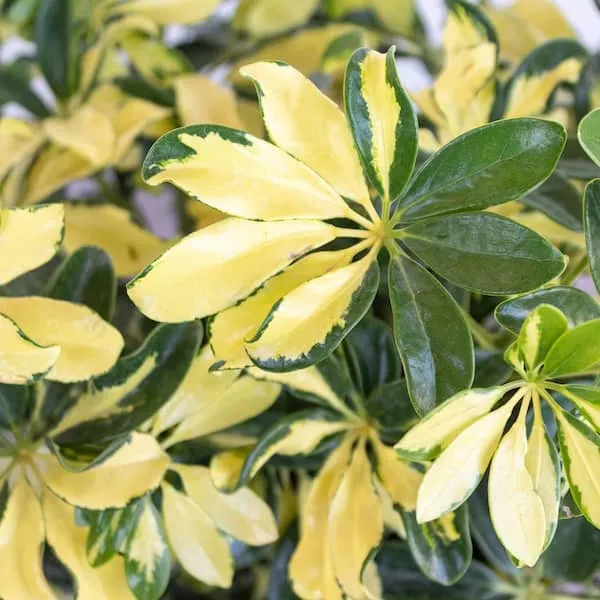Schefflera Care
The Schefflera is an incredibly easy-going houseplant. The clusters of broad leaves cascade from its branches, filling any space with gorgeous green.

How to care for your Schefflera
- LIGHT
Your Schefflera prefers bright indirect light. It can also tolerate medium and low light, but growth will slow. Direct sun in the early morning and late afternoon is fine, but avoid exposure to the harsh midday sun which can scorch the leaves.
- WATER
Water when 75% of the soil volume is dry. Water slowly, allowing it to soak into the soil, until it flows freely through the drainage hole. Discard any excess water that accumulates in the saucer.
- HUMIDITY
Your Schefflera prefers a humid environment. Add a pebble tray or place a humidifier nearby.
- TEMPERATURE
This plant prefers temperatures between 50° – 80°F.
- FOOD
Feed once every month during the spring and summer with an all-purpose fertilizer for indoor plants. No fertilizer is needed in the fall and winter months when growth naturally slows.
- TOXICITY
This plant is considered toxic to pets and humans if ingested.
- ADDITIONAL CARE
Prune your Schefflera regularly to keep it small in size or neatly shaped. Use a clean pair of pruning shears and never remove more than 30% of the plant at a time—any more may shock it. Rotate your plant on a regular basis to promote even, balanced growth.
Common Issues for your Schefflera
Moisture
Your humidity level
Improper Light
Generally, Scheffleras will thrive when placed in medium to bright indirect sunlight. When exposed to direct sunlight for too long, the foliage will burn. While Scheffleras can adapt to low light areas, their growth will slow. Too little light can result in yellowing leaves. Take note of the light your Schefflera is receiving and move accordingly.
Pests
Weakened or stressed Scheffleras become more susceptible to insect infestations. Sap-sucking bugs like spider mites can drain your plant of moisture. This problem quickly manifests itself by yellowing leaflets and fronds. Scale, mealybugs, and spider mites occur frequently in indoor conditions. If not killed early on, these small pests proliferate and move all along frond parts into nooks and crannies. The piercing mouths of the insects exhaust your plant and accelerate yellowing, especially if your Schefflera is already unhealthy from poor lighting, a nutrient deficiency or improper soil moisture.
Some yellowing is natural
Is your Schefflera pushing out new growth? If there is new growth on your plant and the yellowing leaves are older, particularly at the bottom of the plant, this yellowing is natural. Your plant sheds its old leaves and sends energy to new growth.
First, let’s clean up your plant. This allows the plant to direct its energy to new healthy growth.
- Remove entire brown leaves (they will not turn green again) or the affected portion with a pair of sharp scissors or pruning shears.
- Wipe the blades of your scissors with rubbing alcohol between each snip.
- You may need to trim your plant in stages because you never want to remove more than 20% of the affected leaves at one time–this could shock your plant.
- Now, let’s get your Schefflera on the road to recovery.
Incredibly dry soil
Your Schefflera prefers a thorough watering when 50-75% of the soil volume is dry. That said, periods of prolonged drought can cause foliage to brown and dry. Be sure you’re not over or underwatering your plant.
If you accidentally let your Schefflera’s soil dry out completely, you may see leaves go limp, droop, and possibly start to brown and curl. If the soil is extremely dry all the way through the pot, a thorough soak is in order.
Here’s how to soak-water your Schefflera:
- Place your plant in your sink or tub without the saucer. Fill your basin up with about 3-4″ of water. Make sure the water isn’t hot!
- Allow your plant to soak up water through the drainage hole in the bottom of the pot for at least 45 min.
- Feel the top of the soil after your plant has been soaking–has the water reached the top 2-3” of soil?
- If not all the soil feels saturated, water your Schefflera slightly from the top of the soil to help speed up the saturation.
- When your plant’s soil is evenly damp, drain the sink/tub and allow the plant to rest while it drains thoroughly. Place the plant back on its saucer and back in its proper spot.
Increase the humidity
Temperature
Make sure your plant is not in a drafty area or in the path of heating and cooling vents. Leaves will brown and drop if the plant is cold or excessively dry from constant airflow.
